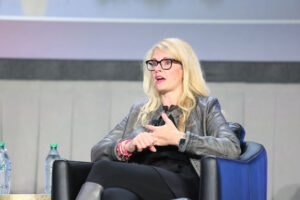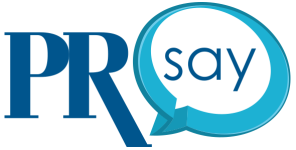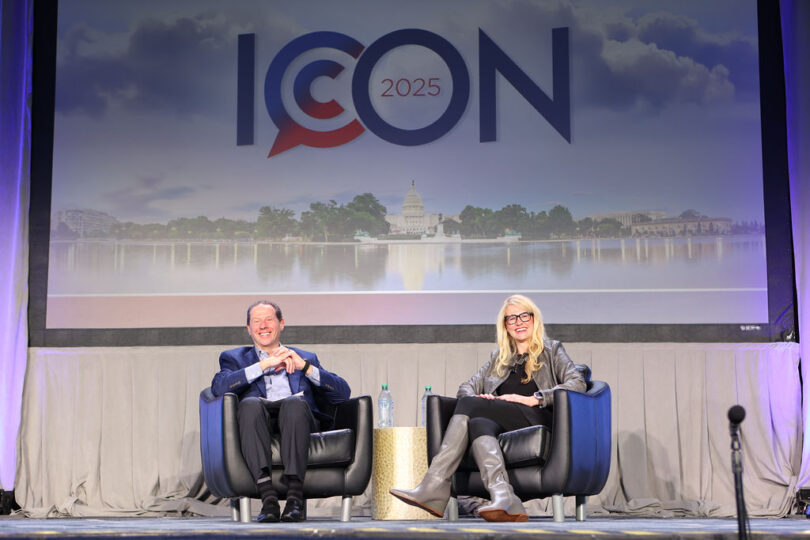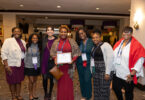Tina Beaty, chief brand and marketing officer at SHRM — the world’s largest business association focused on workplace dynamics — was this morning’s General Session speaker at the Washington Hilton during PRSA’s ICON 2025 in Washington, D.C.
Beaty — who is a wife, a mother of three and a black belt in Tae Kwon Do — always knew she wanted to go into public relations, though she initially imagined herself as a music industry publicist.
“I was always interested in the idea that communications can shape and influence… truly shaping hearts and minds of hundreds of thousands across a demographic, and was really drawn to the psychology behind that.”
In a conversation with Ray Day, APR, 2025 PRSA chair, Stagwell vice chair and Allison Worldwide executive chair, Beaty described SHRM’s mission.
“We represent the world of work — an intersection of employees and employers in an ever-evolving environment.”
The association serves as a voice and governing body for workplace issues, constantly analyzing data and insights to help organizations anticipate what’s next, while providing resources, professional certifications and development for HR professionals.
Reframing inclusion and diversity
Day noted that SHRM had been in the headlines for its move last year to I&D (inclusion and diversity) and asked about the decision to drop the “E” for equity — and how the association has communicated the change.
Beaty acknowledged that while the shift drew some backlash and misunderstanding, “SHRM took a clear and at times controversial stand in shifting to I&D.”
“This really was a communications issue,” she said. “It came down to a misunderstanding, a distraction and a lack of shared definition across the American workforce.”
She explained that SHRM debated whether to redefine the term “equity” or reeducate people about its meaning, but ultimately decided that, when the new I&D framework was introduced in July 2024, the priority was to move forward with inclusion and diversity work first.
“We made the tough decision to prioritize so that we can gain traction on two of the pillars before we try to tackle anything else,” Beaty said, referring to how DEI had expanded to include additional letters. “It was becoming alphabet soup, so we decided to strip it back to its core.”
More than a year later, SHRM is now hearing positive feedback from CEOs and CHROs who appreciate the clarity and focus the change has brought.
“They’ve told us this gave them air cover to follow suit,” she said. “It allowed them to unify their workforces while still taking meaningful action.”
Characterizing work today
“We could rattle off all the change: AI, how the pendulum is swinging between the employer and the employee, and the stakeholders, and employee activism. The temperature is different… but I think the main change has been the speed or the acceleration of that change.”
While trends used to take a while to catch on, now you’re seeing rapid change in 24 hours. Beyond AI, it’s the algorithms, she said, and the ability to serve up info quickly but in small pockets. So everyone is getting personalized content, but you’re only being served part of the story. This yields change and divisiveness at a quick rate, causing consternation and prompting people to seek some control again, she said.
When asked about the changes with remote and hybrid work following the pandemic, Beaty said: “I don’t think anything is permanent. Of any topic.”

Competing for talent
“The data is showing a significant war on talent,” Beaty said.
There are a lot of layoffs happening because they are readjusting for what is coming. “You’re going to see this war on talent really shift to say that there is more talent available and why — are they in it for flexibility, career growth and climbing that corporate ladder?
If you have clarity, consistency and strong leadership and can communicate that, then that’s what strong performers want. They want to win, and they want to be on a team that knows how to win.
“There is a huge opportunity within the talent that you have at your organizations. Look at other folks on your staff — are they showing signs of being hungry?”
Beaty cited a LinkedIn stat that said 65% of jobs will change by 2030, as well as SHRM data that said two out of three Americans are interested in being gainfully employed but don’t have a four-year degree. Yet, HR still has four out of five job descriptions that require a four-year education. “So there is a mismatch right now,” she said.
“Can the individuals be upskilled, can they be reskilled into something? It is more about the power skills — can you lead, do you have the ability to galvanize people… and find efficiencies where maybe there wasn’t before.”
Navigating AI and the changing workforce
When asked by Day if we should fear AI, Beaty responded: “No, I don’t think you can fear AI. It’s here — now should you have healthy dose of skepticism, and governance models and things like that within your organization regarding how you use it, when you use it, what you release to it and what you don’t in terms of your IP, absolutely… but I don’t think fear has any place when it comes to leading through these times of change. This technology is here, and it’s been here, it’s just now in the spotlight because of the acceleration and the ability for anybody to use it.”
While it’s exciting, she cautioned the audience to be aware that it is a monumental change, and that we need to be controlling the change.
“Communicators and HR really need to work together to work on workforce planning in a way that we never had,” she said. Rather than being about staffing models and org charts, the focus should be on taking audits and thinking about what can be automated and where AI can bring immediate efficiencies.”
Developing and demonstrating new skills
Talking about what skills communicators need today, “power skills is an obvious one. The true ability to lead people — people manager skills is going to become even more important,” Beaty said. “Business acumen blended with radical empathy — how do you teach that to someone who is in their mid-career. Another skill is the ability to have critical thinking — that’s what is going to put the human in control of the AI.”
While AI is amazing, you have to prompt it, code it, tell it what to do, provide background and more. “It’s up to the human to understand the entirety of the business landscape, product, staff and make real-time decisions.”
“Critical thinking is going to be more important than it ever has before, along with flexibility and agility,” she said, adding that in a moment of rigor, you could lose a year’s worth of productivity. “We have to be looking at strategic plans as living documents; we need to be taking in data as it comes in real time and pivoting.”
Beaty closed by urging the audience to stay flexible and focused amid constant transformation.
“We need to be making decisions in real time and bringing our teams along on the journey.”
The future of work, Beaty said, isn’t something on the horizon — it’s being defined now, by communicators and leaders who connect people to purpose through clarity, empathy and courage.
Amy Jacques is the managing editor of PRSA’s award-winning publication, Strategies & Tactics.
Photos: Albert Chau Photography







